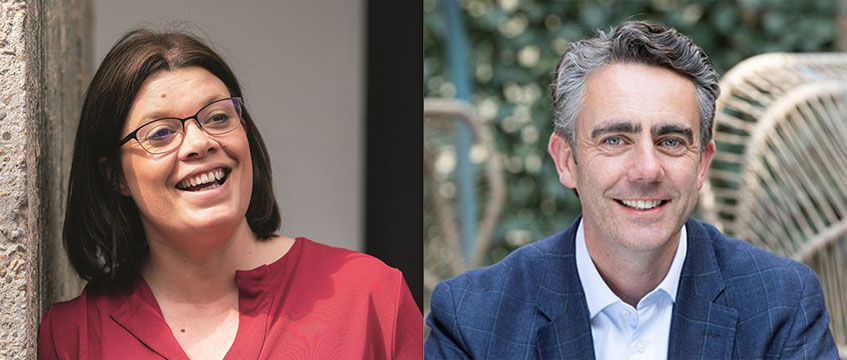In conversation with… GPE’s Janine Cole and Nick Sanderson
Just over a year ago, GPE launched a social impact strategy designed to hold it to account and ensure it delivers at least £10m of social value throughout its estate by 2030.
The strategy was based around four main pillars: enabling healthy and inclusive communities; championing diverse skills and employment opportunities; supporting the growth of local businesses; and connecting people with urban nature.
Catching up with sustainability and social impact director Janine Cole and chief financial and operating officer Nick Sanderson 15 months on from the launch of the strategy, it is clear that the document has had more of an impact than they had imagined, and in different ways than either of them had expected.
Just over a year ago, GPE launched a social impact strategy designed to hold it to account and ensure it delivers at least £10m of social value throughout its estate by 2030.
The strategy was based around four main pillars: enabling healthy and inclusive communities; championing diverse skills and employment opportunities; supporting the growth of local businesses; and connecting people with urban nature.
Catching up with sustainability and social impact director Janine Cole and chief financial and operating officer Nick Sanderson 15 months on from the launch of the strategy, it is clear that the document has had more of an impact than they had imagined, and in different ways than either of them had expected.
Going further
The pair are clearly proud of what the plan has enabled so far but know there is so much further to go. On those four pillars they have achieved numerous results: they have supported local enterprises such as Send Coffee, which provides employment opportunities for people with special educational needs and disabilities, expanding the concept across its sites and utilising it at its events, Pretty Little Cupcakes and Made in Marylebone; they have created more communal spaces in their assets, with the Hickman in Whitechapel as an exemplar, hosting parents’ groups in its Makers café, implementing a “Purple” audit to ensure the space is inclusive and welcoming to people with visible and hidden disabilities, and working collaboratively with local businesses, offering its space for events; and they have run community days with staff, connecting them with nature.
But the plan has had a deeper impact than that. When you speak to Cole and Sanderson, it is clear that the strategy has really made GPE hold a mirror up to itself. It has caused its leaders to stop and pause and consider what role it can really play. It has changed the business and is making it work harder and harder at being better.
“One of the key takeaways has been that being a decent person really isn’t enough,” says Sanderson. “Being a decent person should be entry-level. We are privileged to have an opportunity to make change.”
And for GPE, failing to act on that privilege is not OK. For both Cole and Sanderson, that takeaway has come through the firm’s relationship with its new charity partner, XLP, which helps young people who are at risk of being drawn into gang-related activities, and the work it has done with Arrival, a training and coaching business that provides co-mentoring opportunities for businesses, pairing senior executives with ethnically diverse and socially disadvantaged young people.
Those experiences underlined what Cole had always suspected, but didn’t have the evidence to back up: that ED&I is just as entwined in social impact as the environment is.
“The reason we were so determined to put ED&I into the social impact strategy was that we felt we couldn’t prove it when putting the strategy together, but believed that by integrating it, it would allow us to go faster,” says Cole.
[caption id="attachment_1172601" align="aligncenter" width="847"] GPE is working with charity XLP, which helps young people who are at risk of being drawn into gang-related activities[/caption]
Being bolder
It has certainly pushed the business to be bolder in what it wants to achieve. “Having an inclusive culture is great, but it isn’t enough,” says Sanderson. “You have to put out some very clear targets about representation, because without having the targets it’s not going to happen. Hearing that directly from the talent was what we needed for us to know that we had to do this. The most tangible thing that has come out of the social impact plan so far is the representation targets that we have put in place.”
Those targets are to ensure that the make-up of the GPE business looks like the market in which it operates – central London. “If you look across London, just over 40% of people self-describe as non-white,” says Sanderson. “GPE today is about 20%. So we have set ourselves a five- to six-year goal to get to more than 40% of our people being non-white. That’s quite a long way out, so we have also set ourselves a target to get 20% of the management team to be non-white by 2025.”
The firm also has targets around gender – an aim to improve from today’s 29% female representation to 40%.
For Cole and Sanderson, those targets are all about forcing action and pushing the business from being just a “decent person” to being truly inclusive and representative, and having a real impact on society.
Biggest wins
“The progress we have made on ED&I by bringing our ED&I strategy into social impact has to be the biggest win,” says Cole. “We are not perfect. There is lots to do, but I would go so far as to say that this year has been transformational.”
For finance man Sanderson, the revelation has also been that the social impact GPE can have through changes to the company culture – through co-mentoring lessons and volunteering with kids who just need a little support and structure to see there is a different life out there – is just as valuable as the social impact you can put a cold hard pound sign on.
“The biggest lesson for me personally is the difference between social impact and social value,” he says. “They are both very important, but you have to recognise the trade-offs associated with that, particularly when you have an organisation that is now really excited by this and wanting to do more. Now it’s about figuring out how to allocate the time and the capital in the right way so that we can do more.”
As GPE’s social impact strategy evolves into its second year and rolls closer to its 2030 deadline, the focus for the business will be on ramping up its actions and working better and more closely with its supply chain to ensure they understand the firm’s targets around social impact just as clearly as they can articulate its net zero goals.
To send feedback, e-mail samantha.mcclary@eg.co.uk or tweet @samanthamcclary or @EGPropertyNews











